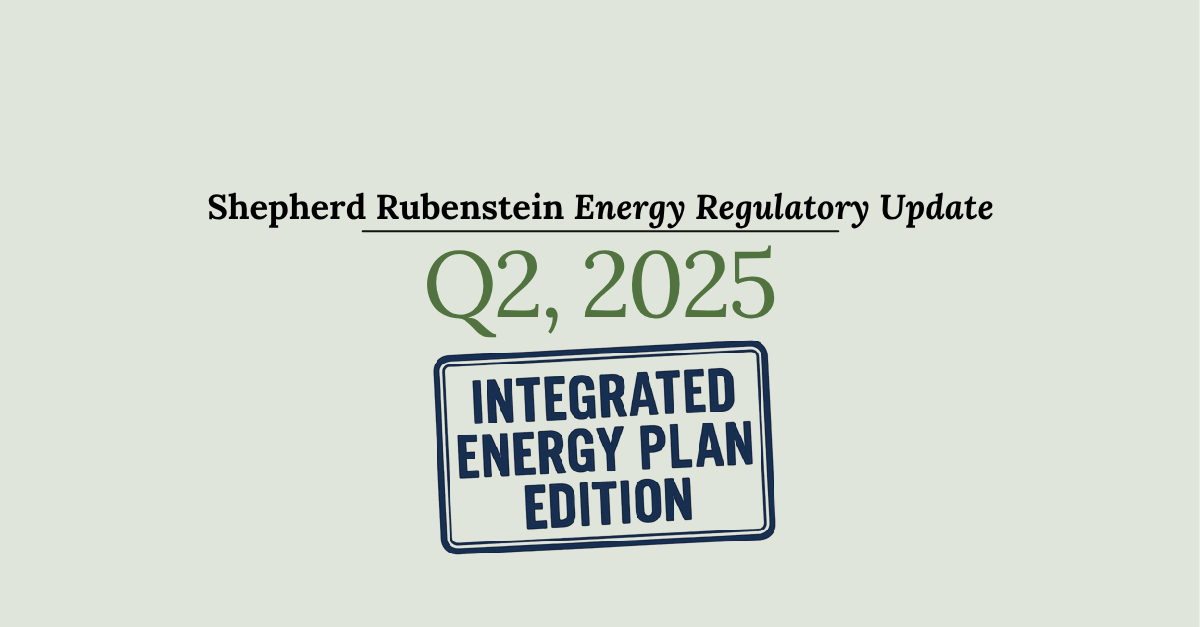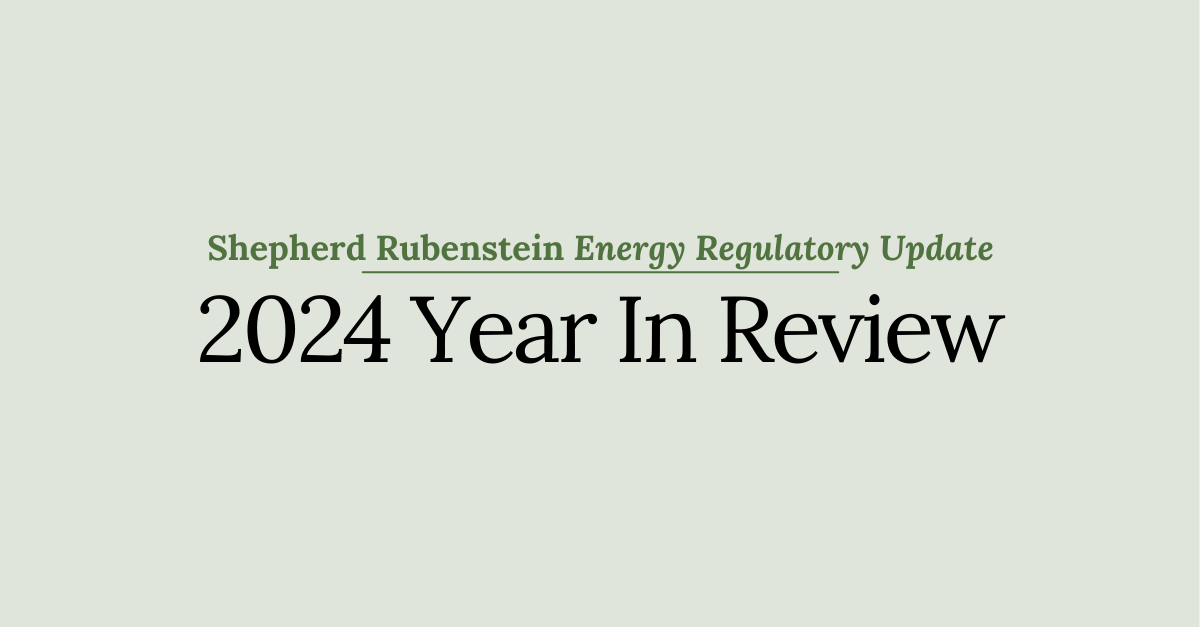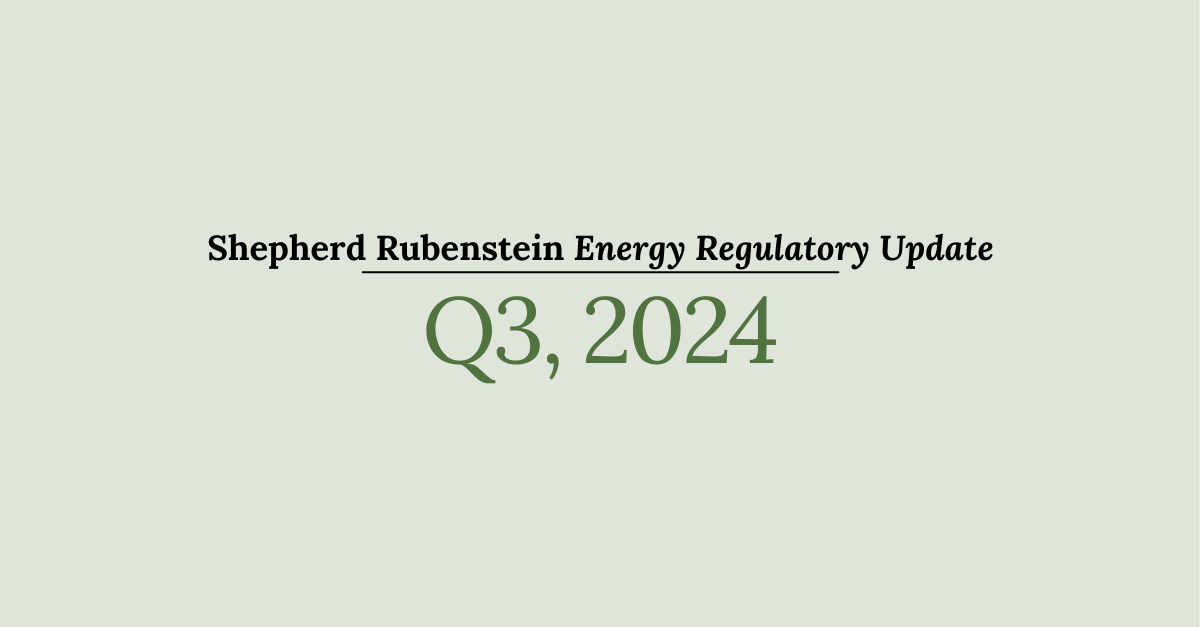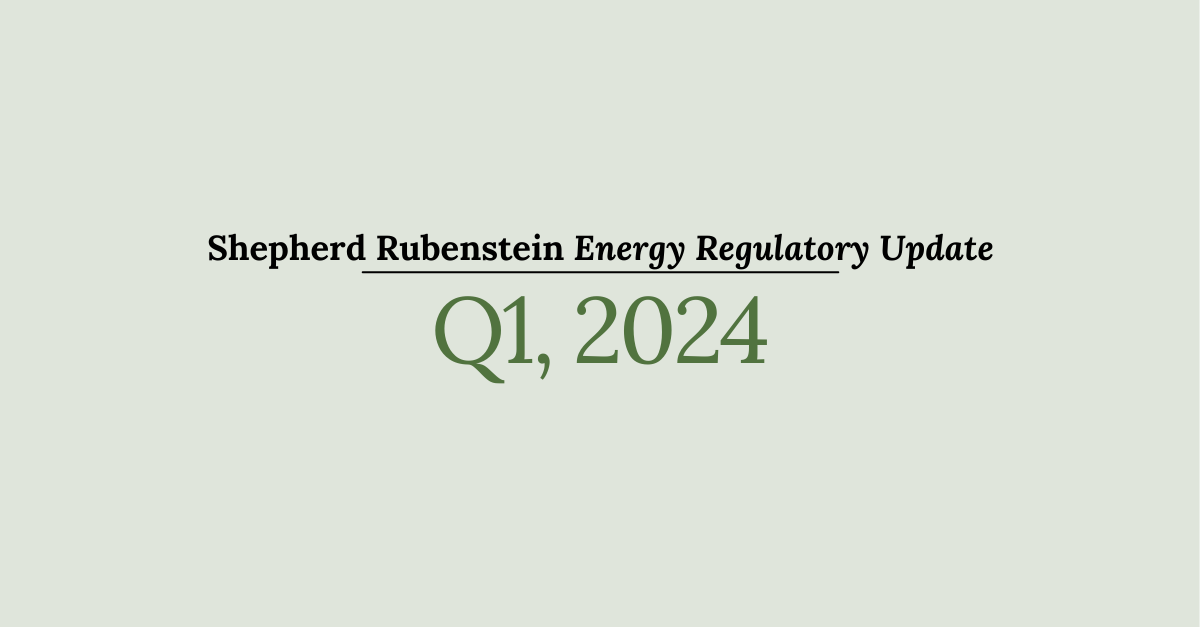Happy Holidays! It has been an eventful year for Ontario’s energy sector. With growing demand, new resource procurements, the release of a highly anticipated expert panel report, a government vision document, two major pieces of legislation, and a wave of new policies, consultations, and regulatory decisions, have brought significant change to energy regulation and policy.
As the year winds down, we’re excited to share the key themes and regulatory developments that, in our view, shaped 2024 in this special Year in Review edition of the Shepherd Rubenstein Energy Regulatory Update.
1. Increasing Demand
Almost all the key themes discussed below are fundamentally driven by the forecast increase in electricity demand in Ontario, spurred by electrification, population growth, and commercial load expansion.
In April, the IESO released its 2024 Annual Planning Outlook (APO), forecasting electricity demand to grow by approximately 2% annually, culminating in a 60% increase by 2050. The 2024 APO also indicated a shift from summer-peaking to dual-peaking by 2030, alongside a growing capacity deficit expected to reach approximately 23 GW by 2050.
Those forecasts were revised in October when the IESO released updated forecasts as part of its upcoming 2025 APO. The IESO now forecasts electricity demand will grow by 2.2% annually, resulting in a 75% increase by 2050. Medium-term peak capacity projections were also adjusted upward, with summer and winter peaks increasing by 700 MW and 900 MW, respectively. By 2025, peak demand is expected to rise by 50–60% compared to previous forecasts for the same year. The IESO attributes these upward revisions to increased electrification in the commercial sector, growth in data centers, and the expansion of EV production and supply chains.
2. Resource Procurement
The significant resource procurement activity that began in 2023 intensified in 2024.
As part of the first phase of its Resource Adequacy Framework, the IESO announced the results of its Long-Term 1 RFP (LT1 RFP) procurement process, targeting capacity between 2026 and 2028. The IESO procured 1,784 MW of storage capacity at a weighted average price of $673.32/MW (per business day) and 411 MW of non-storage capacity (almost exclusively natural gas generation).
The IESO engaged stakeholders on its planned Long-Term 2 RFP (LT2 RFP), which will feature both energy and capacity streams, as well as a Long Lead Time (LLT) resources stream. The LT2 RFP energy stream will use the Enhanced Power Purchase Agreement (E-PPA) revenue model. To inform the design of the LLT procurement, the IESO launched a Request for Information (RFI) focused on long lead time resources, specifically long-duration storage and hydroelectric generation. Recognizing the significant impact of the LT2 RFP on potential projects, the then Minister of Energy and the Minister of Agriculture, Food, and Rural Affairs jointly wrote to the IESO outlining policy considerations for energy projects on agricultural land. The Mid-Term 2 (MT2) RFP, targeting existing resources, was accelerated to precede the LT2 RFP, with submissions due in early January 2025.
In mid-December, the Minister of Energy and Electrification issued a procurement directive, that among other things, directs the IESO to move forward with the LT2 RFP with a multiple-window approach, targeting a total of 14 TWh through the energy stream and 1,600 MW through the capacity stream. The IESO is targeting 3 TWh of energy and 500 MW of capacity as part of its first window, with a submission deadline in Q3, 2025.
The Minister also announced an increase in the broader procurement capacity target, raising it from 5,000 MW to 7,500 MW, in response to updated demand forecasts as part of the upcoming 2025 APO. Additionally, the Minister directed the IESO to report back by the end of April with options for procuring long-lead time resources, as well as a program to re-contract existing small-scale distribution-connected generation and acquire new resources.
The IESO is still assessing two pump storage projects in Meaford (TC Energy and Saugeen Ojibway Nation) and Marmora (OPG and Northland Power), which were previously deemed less favorable than other alternatives. In January, the then Minister of Energy directed the IESO to collaborate with other ministries and project proponents to evaluate the broader social and economic benefits of these projects. The Minister also requested the Ministry of Energy to work with the OEB and project proponents on cost recovery mechanisms for his consideration.
Additionally, the IESO was directed to extend the contracts of the Atikokan and Hornepayne biomass generating stations.
Hydroelectric generation also saw notable developments. In addition to the IESO RFI, the Small Hydro Program was modified to allow the aggregation of contracts. At the Minister’s request, the IESO began engaging stakeholders to design a Northern Hydro Program (NHP), focused on re-contacting large existing hydroelectric facilities. The Minister of Energy and Electrification also announced the Government’s support for Ontario Power Generation’s (OPG) plans to refurbish the Sir Adam Beck, R.H. Saunders, and several other Eastern Ontario hydroelectric stations.
3. Planning To Do Integrated Planning
This year may be remembered as the year of planning for integrated planning.
It began with the release of the Electrification and Energy Transition Panel’s (EETP) final report, Ontario’s Clean Energy Opportunity. This comprehensive report outlines a recommended path for Ontario’s transition to a clean economy, guided by seven key principles. It also includes 29 specific recommendations across five areas: planning for electrification and the energy transition, governance and accountability, true partnerships with Indigenous partners, innovation and economic development, and consumer, citizen, and community perspectives.
In the fall, the Government released its energy vision document, Ontario’s Affordable Energy Future: The Pressing Case for More Power, which highlights priorities across three themes: planning for growth, affordable and reliable energy, and becoming an energy superpower, to achieve its vision of an affordable, reliable, and clean energy economy.
The vision document was followed up by the Government’s introduction and passage of Bill 214, the Affordable Energy Act. This legislation amends the Electricity Act, creating a legislative framework for the proposed integrated energy plan and outlining its goals and objectives. Simultaneously, the Minister of Energy and Electrification launched a consultation process for the integrated energy plan, expected to be released in early 2025.
A component of an integrated energy plan is conservation. The IESO was tasked with preparing a new electricity efficiency framework that is more enduring and has a longer timeframe than previous models. The Ministry of Energy and Electrification conduced a consultation on the framework and its delivery model, and then issued a procurement directive approving an Enhanced DSM (eDSM) Framework which will begin in 2025 and run through 2036, and have a budget of $10.9B. The initial 3-year eDSM plan will have a budget of $3.2B. Bill 214 also includes amendments to the Electricity Act that authorize the IESO to administer programs supporting beneficial electrification, aimed at promoting electrification and reducing emissions. Concurrently, the Ministry launched consultations on a proposed beneficial electrification program designed to coordinate with energy efficiency programming. In terms of natural gas conservation, the OEB released its Achievable Potential Study, and Enbridge has filed its proposed 2026-2030 demand-side management plan.
The Federal Government has launched its Clean Electricity Strategy, outlining current and planned actions to support a decarbonized and expanded electricity grid.
4. Role of Natural Gas
The Ontario Government’s response to the OEB’s Phase 1 Decision in Enbridge’s 2024-2028 rate application, as well as the broader question of the role of natural gas in the Ontario energy system, was a major focus of the energy regulatory and policy discussions this year.
Just before the 2023 holidays, the OEB released its Phase 1 Decision. As part of that complex decision, the OEB ordered (with one commissioner dissenting) that, beginning in 2025, all new low volume connecting customers would bear their connection costs upfront. Unhappy with the decision to set the customer connection revenue horizon to zero, on the grounds that it would increase the costs of constructing new homes, the then Minister of Energy announced the day after the decision was released, that the Government would use its authority to pause the decision and introduce legislation to reverse it. Shortly thereafter, in January, Enbridge filed both a motion to review and a notice of appeal regarding the Phase 1 Decision, including with respect to other aspects.
In February, the Government followed through on its promise, introducing and later passing Bill 165, the Keeping Energy Costs Down Act, 2024, which overturned the OEB’s determination on the revenue horizon issue. Among other provisions, authorized the Government to regulate the revenue horizon used by the OEB when setting natural gas distribution rates, at least until the earlier of January 1, 2029, or a generic hearing, which Bill 165 gave the Government authority to mandate. After the legislation received royal assent, the Government issued a regulation maintaining the status quo revenue horizon of 40 years for small volume customers and 20 years for others.
Bill 165 also authorized the Minister to issue directives requiring the OEB, in considering leave to construct applications for natural gas transmission or distribution/transmission pipelines, to mandate that all customers bear the full cost of the line without requiring the payment of any capital contribution or surcharge. The legislation included a specific provision addressing orders made between the introduction of the legislation and the end of 2024, clearly aimed at the Enbridge Panhandle Reinforcement Project proceeding, where several intervenors had raised the issue of capital contributions. Ultimately, the OEB approved the project and rejected (in a split decision) the imposition of capital contributions on new large connecting customers.
The legislation, along with other pronouncements, such as those included in the Affordable Energy Future vision document, has signaled the Ontario Government’s support for the natural gas system. It indicated that it would include a Natural Gas Policy Statement as part of its integrated energy plan to “provide clear direction on the role of natural gas in Ontario’s future energy system” which it is currently consulting on.
To speed up the regulatory process of certain natural gas infrastructure, the Government through Bill 165 and subsequent regulations, exempted hydrocarbon pipeline projects from the leave to construct requirements if the project cost is no more than $10 million and the OEB determines that the duty to consult has been adequately discharged. Additionally, the regulation limited when leave to construct approval from the OEB is required for the relocation or reconstruction of hydrocarbon lines and is consulting on further broadening these exemptions.
The OEB approved the Settlement Proposal in Phase 2 of Enbridge Gas’s 2024-2028 rate application, which represented a substantial agreement on the company’s 2025-2028 rate framework.
Regarding electricity generation, the IESO secured 410 MW of additional natural gas generation as part of the LT1 RFP. The Ontario Government has also pushed back against the Federal Government’s draft Clean Energy Regulations (CER), which would impose significant restrictions on natural gas generation. Earlier this year, Environment and Climate Change Canada released a public update report on the draft CER. The report summarized feedback it had received and proposed changes for further comment. The IESO submitted comments on the draft CER, and in late November, the Minister of Energy and Electrification sent an additional letter to the relevant Federal Ministers. The letter cited IESO’s analyses indicating that the regulations would impose a steep cost on Ontario ratepayers for the necessary replacement generation and transmission infrastructure. In mid-December, the Environment and Climate Change Canada issued the final CER, which did include several significant changes. However, they do not appear address all the concerns the IESO had raised regarding the implications for Ontario.
5. Nuclear Renaissance
It has been another big year for nuclear.
The Ontario Government announced its support for OPG’s plan to proceed with the initiation phase of the refurbishment of the Pickering Nuclear Generating Station’s B units (5-8).
Bruce Power filed its initial project description with the Impact Assessment Agency of Canada (IAAC) for Bruce C, marking the beginning of the federal impact assessment process. Earlier in the year, the then Minister of Energy issued a directive to the IESO to enter into a funding agreement with Bruce Power to support a portion of the IAAC process.
The Nuclear Waste Management Organization (NWMO) announced its selection of the Township of Ignace and the Wabigoon Lake Ojibway Nation as the site for Canada’s deep geological repository for used nuclear fuel.
The Canadian Nuclear Safety Commission (CNSC) determined that OPG’s existing environmental assessment approval for a new nuclear facility applies to its proposed Darlington Small Modular Reactor (SMR) project. The CNSC also began hearings on OPG’s application for a licence to construct the first SMR (BWRX-300) reactor. Additionally, the CNSC approved OPG’s application to operate Pickering units 5 to 8 until the end of 2026. Pickering Unit 1 was shut down earlier this fall, and Unit 4 is expected to be shut down by the end of the year.
In late November, the Ministry of Energy and Electrification announced that the Government had asked OPG to begin discussions with Indigenous, community, and municipal leaders regarding the potential use of its existing sites (Wesleyville, Nanticoke, and Lambton) for new generation facilities, including potentially for new nuclear.
Nuclear power is also expected to play a major role in the Ontario Government’s upcoming integrated energy plan. As part of Bill 214, the Government explicitly required that one of the plan’s goals and objectives is “the prioritization of nuclear power generation to meet future increases in the demand for electricity”.
6. Evolving Distribution Sector
New technologies, the energy transition, and electrification are driving an evolution in the distribution sector.
Each was front and center in Toronto Hydro’s 2025-2029 Custom IR applications, which resulted in an OEB approved comprehensive settlement.
The OEB continued its efforts to encourage the use of non-wires solutions (NWS) by distributors as cost-effective alternatives to traditional infrastructure investments. It issued its Non-Wires Solutions Guidelines for Electricity Distributors (NWS Guidelines), replacing the existing CDM Guidelines for electricity distributors. The new guidelines reflect developments since 2021 and acknowledge that NWS addressing system needs can include a broader range of solutions beyond traditional CDM. Additionally, the OEB finalized Phase 1 of its Benefit-Cost Analysis (BCA) Framework for Addressing Electricity System Needs. Starting with applications filed in 2026, the BCA Framework will apply to all electricity distribution capital investments greater than $2 million.
The OEB is also considering changes to its rate-setting framework, starting with distributors. In response to last year’s Letter of Direction, it submitted a report to the Minister of Energy and Electrification, concluding that utilities’ remuneration based on traditional capital infrastructure deployment remains the most cost-effective model. Following this report, the OEB launched its Advancing Performance-Based Rate Regulation consultation. In the short term, this consultation will explore adding performance incentives and mandates, with the long-term goal of considering more fundamental changes to the rate-setting approach. Additionally, the OEB initiated a review of its Incremental Capital Module (ICM) Policy.
As part of its broader Distribution Sector Resiliency, Responsiveness, and Cost Efficiency (DRRCE) initiative, the OEB launched its Vulnerability Assessment and System Hardening (VASH) project. The VASH project aims to incorporate climate resiliency into asset and investment planning, regularly assess system vulnerabilities during severe weather events, and prioritize value for customers when investing in resilience-focused system enhancements.
With the increased use of electric vehicles (EVs), the OEB finalized amendments to the Distribution System Code (DSC) to facilitate the connection of EV infrastructure. These changes included the creation of standardized Electric Vehicle Charging Connection Procedures and a requirement for distributors to include a separate index for EV connections in their Conditions of Service. OEB Staff also released a discussion paper for comment, proposing a reduced Retail Transmission Service Rate (RTSR) for public EV charging stations with low load factors.
To facilitate DER adoption, the OEB amended the DSC to enable electricity distributors to provide flexible hosting capacity arrangements and provided guidance for the phased implementation of new requirements for distributors to publish capacity information maps.
On the innovation front, the OEB updated its Innovation Handbook and approved, with modifications, Essex Powerlines’ request to establish a new deferral account for recording costs related to energy and capacity payments for participants in its PowerShare Distribution System Operator pilot project. However, the OEB also rejected Toronto Hydro’s proposed Innovation Fund citing a number of deficiencies. The IESO issued the final Evaluation Report for the York Region Non-Wires Alternatives Demonstration Project.
7. Indigenous Participation and Engagement
There was increased recognition of the importance of Indigenous economic participation and engagement in the energy sector.
A significant portion of the EETP’s Report focused on advancing meaningful Indigenous participation and partnerships in the energy sector, including several specific recommendations. The Affordable Energy Future vision document also highlighted the importance of Indigenous leadership and participation in energy planning. Similar emphasis was reflected in the work of the Federal Ministerial Working Group on Regulatory Efficiency for Clean Growth Projects, the Canada Electricity Advisory Council, and in the Federal Government’s Powering Canada’s Future: A Clean Electricity Strategy.
As part of the IESO’s development of a Transmission Selection Framework, it proposed requiring proponents to demonstrate Indigenous participation. The Ontario Government also announced that, as part of OPG’s discussions with Indigenous leaders regarding the potential for new generation facilities at three of its existing sites, it would include considerations for how those communities could be supported through equity participation.
There were high levels of Indigenous participation in the LT1 RFP, with 9 of the 10 successful storage projects involving at least 50% First Nations equity participation. LT2 RFP will similarly include rated criteria for projects with Indigenous participation.
In its 2024 Budget, the Federal Government announced up to $5 billion for a new Indigenous Loan Guarantee Program to support energy and natural resource projects. As part of the Fall Economic Statement, the Federal Government followed up with an announcement the launch of the Canada Indigenous Loan Guarantee Corporation. Barriers to Indigenous participation were also raised in the context of the OEB’s generic hearing on the cost of capital.
In terms of Indigenous engagement and consultation, the IESO issued its first Indigenous Engagement Framework. The OEB sought feedback from Indigenous communities and organizations, as well as natural gas utilities and other stakeholders, on proposed revisions to its Environmental Guidelines for the Location, Construction, and Operation of Hydrocarbon Projects and Facilities in Ontario regarding Indigenous consultation requirements. Additionally, the Federal Government’s 2024 Budget announced the establishment of a Crown Consultation Coordinator.
8. Intersection Between Energy and Housing Policy
Over the past year, the Ontario Government has implemented energy policy changes to advance its broader goals of increasing housing supply and enhancing affordability.
In response to a request included in the Minister of Energy’s 2023 Letter of Direction, the OEB undertook a consultation to review electricity distribution system expansion policies for housing developments, with a focus on connection and revenue horizons. Each of the resulting recommendations included in the OEB’s report was endorsed by the Minister of Energy and Electrification.
The OEB has begun implementing the most significant recommendation by issuing a Notice to Amend the Distribution System Code. This amendment would extend the maximum connection horizon for housing developments from 5 to 15 years, and extend the revenue horizon for residential connections from 25 to 40 years. Additionally, the OEB initiated a consultation process and established an advisory group to develop a cost allocation model. This model aims to allocate costs in cases where significant initial system expansion into a development area is required, and the associated costs are borne solely by the initial connecting customers.
As part of Bill 214, the Government gained new authority regarding the Transmission System Code (TSC) and the DSC. This includes the ability to issue regulations specifying amendments to the DSC or exempting entities from its application, particularly regarding cost allocation and cost recovery for new infrastructure as part of the distribution system. The Minister of Energy and Electrification’s consultation on these regulations also focused on addressing ‘first mover’ costs on the distribution system. It also examined the assurances distributors need to build certain facilities in anticipation of growth, even when not all capacity has confirmed customers.
9. Transmission
Not as high-profile as many other themes in 2024, but there were important regulatory developments throughout the year regarding the transmission system.
The OEB granted leave to construct Hydro One’s proposed Waasigan Transmission Line and St. Clair Transmission Line (Lambton TS to Chatham SS). The Ministry of Energy and Electrification declared the planned transmission line from Wawa TS to Porcupine TS a priority project and designating Hydro One as the transmitter.
There was significant focus on connection costs. The OEB launched a review of the connection-related sections of the Transmission System Code (TSC) and formed a working group. As part of Bill 214, the Government now has the authority to pass regulations amending the TSC, or exempting entities from its application concerning cost allocation and cost recovery for the construction, expansion, and reinforcement of the transmission system. The Minister of Energy and Electrification consulted on developing these regulations, which aim to reduce costs for ‘first movers’ and provide transmitters (and distributors) with the assurances needed to build certain connection infrastructure.
The OEB also handled several single-asset transmitter rate applications. It approved three settlement proposals (B2M LP, Niagara Reinforcement LP, and Chatham x Lakeshore LP), establishing a new 5-year revenue requirement framework for single-asset transmitters. Additionally, it approved a rate adjustment application brought by Upper Canada Transmission 2, which operates the East-West Tie Line. This approval included a $30 million disallowance related to project cost overruns, primarily due to the COVID-19 pandemic.
As part of implementing last year’s Powering Ontario’s Growth, the IESO completed its engagement to develop a Transmission Selection Framework in preparation for its required report to the Minister of Energy and Electrification in September. The IESO proposed that for certain projects it would conduct an RFP among qualified bidders. The successful proponent would be awarded a partial contract running until shortly after commercial operations begin. This partial contract would cover design, construction, and a fixed level of O&M costs, which would then be included in an OEB cost of service application. Additionally, some or all of the post-commercial revenue would be fixed via contract.
10. Market Renewal Program Implementation
We are now just months away from the scheduled implementation of the Market Renewal Program (MRP) in May 2025.
This past year, the Technical Panel unanimously recommended approval of the final alignment batch of market rule amendments to implement the MRP. This followed the IESO making several substantive changes to the market rules and manuals, including the establishment of a Market Power Mitigation Working Group. The market rules amendments were subsequently approved by the IESO Board of Directors.
The IESO has spent much of the year focusing on market participant readiness. The OEB has also prepared for the implementation of the MRP, issuing a letter outlining expected amendments to various codes, and provided draft accounting guidance related to commodity pass-through accounts.
However, the implementation schedule is now in doubt. In November, several non-quick start natural gas generators filed an application with the OEB seeking a review of the MRP market rule amendments. The application requests that the amendments be revoked and sent back to the IESO for reconsideration. The statutory deadline for the OEB to decide on the application is March 6, 2025.
As always, if you have any questions, or think we can be of assistance to you or your organization, please do not hesitate to reach out to Mark Rubenstein at mark@shepherdrubenstein.com.
Click here for pdf version.








